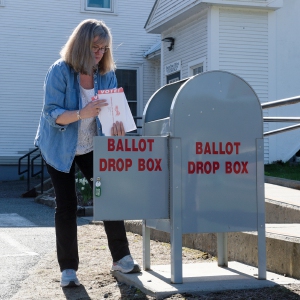Thousands of Vermonters applied for FEMA assistance after last summer’s floods. What became of them?
| Published: 02-06-2024 5:49 PM |
Last month, Sue Minter, the executive director of the Barre-based nonprofit Capstone Community Action, explained to state lawmakers how many Vermonters are still facing the impacts of last summer’s floods.
“Many are either displaced entirely or living in substandard or even unsafe conditions,” Minter said in testimony to two House committees. “They live in mold, they live in cold and they live without everything they had before this disaster.”
Now, Federal Emergency Management Agency data provided to VTDigger by the state sheds more light of what became of flood-displaced Vermonters — and underscores the profound and sustained impact of the disaster on Vermonters’ housing situations.
After historic rainfall flooded homes last summer, thousands of Vermonters sought help from FEMA. Roughly 6,300 households — representing roughly 14,000 Vermonters — applied for federal assistance through FEMA after the July flooding, according to the data.
Those figures, which are current as of Feb. 1, show the “total people impacted in some way,” said Douglas Farnham, deputy secretary of the Agency of Administration and the state’s chief recovery officer. “From a completely destroyed home down to just some water damage in the basement.”
According to the data, 295 households — made up of an unknown number of individuals — told FEMA that they had since left Vermont for other states.
Eric Peterson, the program manager for Capstone’s disaster case management program, said those figures are not surprising given Vermont’s tight housing market.
“So I would assume some of them have probably moved away permanently for other housing opportunities,” Peterson said. “(For) some of them, that might be a temporary thing until they have a safe habitable place to stay again in-state.”
Article continues after...
Yesterday's Most Read Articles
Another 677 households reported that they had relocated to a new ZIP code within Vermont. Forty-eight individual Vermonters who sought aid from FEMA reported that they were now experiencing homelessness, while 89 people were receiving rental assistance from FEMA as of the start of the month.
The agency is also providing housing directly to another 19 Vermonters. That means the federal agency is offering a “manufactured housing unit” or leasing an existing unit, according to FEMA’s website.
Of those roughly 6,300 applicants for FEMA assistance, 2,600 did not qualify, according to Farnham.
That could be the case for many reasons: Applicants might have already had insurance, or did not submit enough information, or may have submitted duplicate applications. Household damage may have been “insufficient or not caused by the flood,” according to Farnham, or a household may have withdrawn its application. Households are able to appeal if their applications are not accepted.
But the real impact of the flooding is likely much more widespread than those figures capture, Minter said in an interview.
Capstone, which connects low-income Vermonters with resources and services, has worked closely with flood-displaced residents — many of whom never applied for FEMA assistance, Minter said.
And for those who were rejected — but may yet be eligible — the appeals process can be overwhelmingly difficult.
Dealing with FEMA is not “easy for people who have been flooded, and already really don’t have the capacity either,” she said. “They’re in crisis, emotional and otherwise. They’re living in a car. They have no computer. They have no computer skills. They have no technology. They have no phone.”
What’s more, Farnham said, the federal agency can only respond to the direct impacts of the disaster, and not other challenges exacerbating the situation — such as the state’s crushing housing shortage.
FEMA officials “don’t take into account the conditions that we were grappling with when the flood hit,” Farnham said. “And I think that’s the hardest thing for us to separate on the ground and at the state level — is we had a number of vulnerable people that we were trying to support even going into the flood.”

 Students take down pro-Palestinian encampment at UVM
Students take down pro-Palestinian encampment at UVM Sharon voters turn back proposal to renovate school
Sharon voters turn back proposal to renovate school Dartmouth administration faces fierce criticism over protest arrests
Dartmouth administration faces fierce criticism over protest arrests
